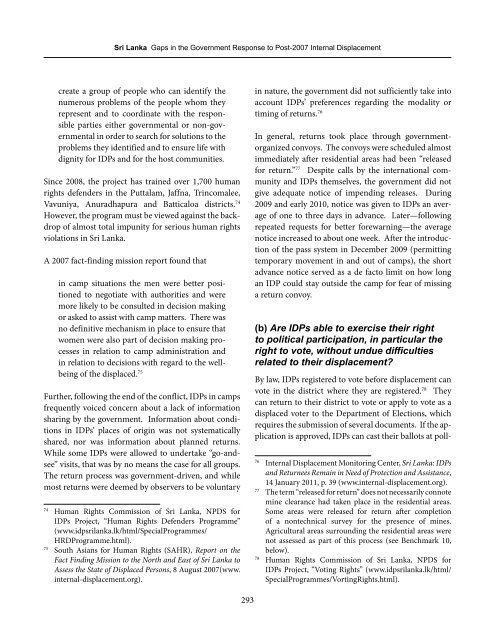From Responsibility to Response: Assessing National - Brookings
From Responsibility to Response: Assessing National - Brookings
From Responsibility to Response: Assessing National - Brookings
Create successful ePaper yourself
Turn your PDF publications into a flip-book with our unique Google optimized e-Paper software.
Sri Lanka Gaps in the Government <strong>Response</strong> <strong>to</strong> Post-2007 Internal Displacement<br />
create a group of people who can identify the<br />
numerous problems of the people whom they<br />
represent and <strong>to</strong> coordinate with the responsible<br />
parties either governmental or non-governmental<br />
in order <strong>to</strong> search for solutions <strong>to</strong> the<br />
problems they identified and <strong>to</strong> ensure life with<br />
dignity for IDPs and for the host communities.<br />
Since 2008, the project has trained over 1,700 human<br />
rights defenders in the Puttalam, Jaffna, Trincomalee,<br />
Vavuniya, Anuradhapura and Batticaloa districts. 74<br />
However, the program must be viewed against the backdrop<br />
of almost <strong>to</strong>tal impunity for serious human rights<br />
violations in Sri Lanka.<br />
A 2007 fact-finding mission report found that<br />
in camp situations the men were better positioned<br />
<strong>to</strong> negotiate with authorities and were<br />
more likely <strong>to</strong> be consulted in decision making<br />
or asked <strong>to</strong> assist with camp matters. There was<br />
no definitive mechanism in place <strong>to</strong> ensure that<br />
women were also part of decision making processes<br />
in relation <strong>to</strong> camp administration and<br />
in relation <strong>to</strong> decisions with regard <strong>to</strong> the wellbeing<br />
of the displaced. 75<br />
Further, following the end of the conflict, IDPs in camps<br />
frequently voiced concern about a lack of information<br />
sharing by the government. Information about conditions<br />
in IDPs’ places of origin was not systematically<br />
shared, nor was information about planned returns.<br />
While some IDPs were allowed <strong>to</strong> undertake “go-andsee”<br />
visits, that was by no means the case for all groups.<br />
The return process was government-driven, and while<br />
most returns were deemed by observers <strong>to</strong> be voluntary<br />
74 Human Rights Commission of Sri Lanka, NPDS for<br />
IDPs Project, “Human Rights Defenders Programme”<br />
(www.idpsrilanka.lk/html/SpecialProgrammes/<br />
HRDProgramme.html).<br />
75 South Asians for Human Rights (SAHR), Report on the<br />
Fact Finding Mission <strong>to</strong> the North and East of Sri Lanka <strong>to</strong><br />
Assess the State of Displaced Persons, 8 August 2007(www.<br />
internal-displacement.org).<br />
293<br />
in nature, the government did not sufficiently take in<strong>to</strong><br />
account IDPs’ preferences regarding the modality or<br />
timing of returns. 76<br />
In general, returns <strong>to</strong>ok place through governmen<strong>to</strong>rganized<br />
convoys. The convoys were scheduled almost<br />
immediately after residential areas had been “released<br />
for return.” 77 Despite calls by the international community<br />
and IDPs themselves, the government did not<br />
give adequate notice of impending releases. During<br />
2009 and early 2010, notice was given <strong>to</strong> IDPs an average<br />
of one <strong>to</strong> three days in advance. Later—following<br />
repeated requests for better forewarning—the average<br />
notice increased <strong>to</strong> about one week. After the introduction<br />
of the pass system in December 2009 (permitting<br />
temporary movement in and out of camps), the short<br />
advance notice served as a de fac<strong>to</strong> limit on how long<br />
an IDP could stay outside the camp for fear of missing<br />
a return convoy.<br />
(b) Are IDPs able <strong>to</strong> exercise their right<br />
<strong>to</strong> political participation, in particular the<br />
right <strong>to</strong> vote, without undue difficulties<br />
related <strong>to</strong> their displacement?<br />
By law, IDPs registered <strong>to</strong> vote before displacement can<br />
vote in the district where they are registered. 78 They<br />
can return <strong>to</strong> their district <strong>to</strong> vote or apply <strong>to</strong> vote as a<br />
displaced voter <strong>to</strong> the Department of Elections, which<br />
requires the submission of several documents. If the application<br />
is approved, IDPs can cast their ballots at poll-<br />
76 Internal Displacement Moni<strong>to</strong>ring Center, Sri Lanka: IDPs<br />
and Returnees Remain in Need of Protection and Assistance,<br />
14 January 2011, p. 39 (www.internal-displacement.org).<br />
77 The term “released for return” does not necessarily connote<br />
mine clearance had taken place in the residential areas.<br />
Some areas were released for return after completion<br />
of a nontechnical survey for the presence of mines.<br />
Agricultural areas surrounding the residential areas were<br />
not assessed as part of this process (see Benchmark 10,<br />
below).<br />
78 Human Rights Commission of Sri Lanka, NPDS for<br />
IDPs Project, “Voting Rights” (www.idpsrilanka.lk/html/<br />
SpecialProgrammes/VortingRights.html).

















